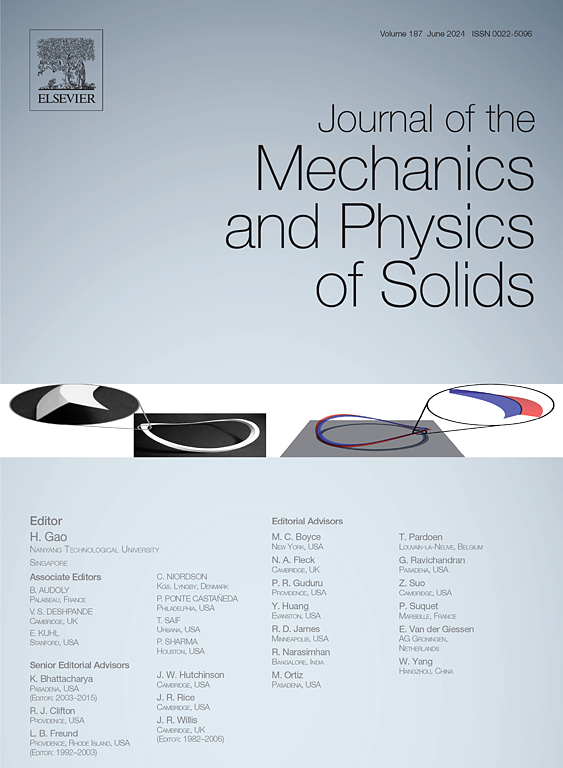之外均化
IF 6
2区 工程技术
Q2 MATERIALS SCIENCE, MULTIDISCIPLINARY
引用次数: 0
摘要
均质化理论是为计算平均扰动的适当测量而设计的,当平均扰动由波长远远大于介质性质变化的微观长度尺度的波组成时。在过去的几年里,该理论已经扩展到适用于超材料,其有效特性包括在接近微结构部件谐振频率的频率上显著的异常耦合。本文讨论的是适用于这一范围以外的理论的发展。对于随机介质,平均扰动的自然测度是集合均值。这是由在空间和时间上非局部的有效性质所控制的,这使得边值问题的解决变得非常复杂。更复杂的是,平均波随着传播距离的增加而衰减,但能量是守恒的。到目前为止,只有一种配置明确地说明并解决了这个明显的悖论。平均波损失的能量在传播过程中传递给扰动的平均零分量。对于时谐激励时的平均能量通量,也证明了这一点。对完全依赖于时间的解决方案的需求提供了本演讲的动机。基于最小作用原理,提出了一种新的随机变分结构,该结构同样适用于非线性弹性响应和时变微结构。而不是集中在有效的性质,它允许使用有限的统计信息,适用于每个单独的实现近似的结构。当介质的性质与时间无关时,这些近似与平均能量守恒一致,这个结果比在时间谐波情况下得到的结果更强。本文章由计算机程序翻译,如有差异,请以英文原文为准。
Beyond homogenisation
The theory of homogenisation is designed for calculating an appropriate measure of the mean disturbance, when the mean disturbance consists of waves whose wavelength is much greater than the microscopic length scale over which the properties of the medium vary. Over the last several years, the theory has been extended to be applicable to metamaterials whose effective properties include significant unusual couplings at frequencies close to the resonant frequencies of microstructural components. This article is concerned with the development of theory that is applicable beyond this range. For a random medium, the natural measure of the mean disturbance is the ensemble mean. This is governed by effective properties that are non-local in space and time, significantly complicating the solution of boundary value problems. A further complication is that mean waves decay with distance of propagation and yet energy is conserved. There has been so far just one configuration for which this apparent paradox is explicitly stated and resolved. The energy lost from the mean wave is transferred during propagation to the mean-zero component of the disturbance. This was demonstrated for the mean energy flux during time-harmonic excitation. The need for fully time-dependent solutions provides the motivation for this presentation. A new stochastic variational structure based on the principle of least action is developed, which is applicable also to nonlinear elastic response and to time-dependent microstructures. Rather than concentrating on effective properties, it permits the construction of approximations which make use of limited statistical information, applicable to each individual realisation. When the properties of the medium are time-independent, these approximations are consistent with mean energy conservation, a result stronger than that already obtained in the time-harmonic case.
求助全文
通过发布文献求助,成功后即可免费获取论文全文。
去求助
来源期刊
CiteScore
9.80
自引率
9.40%
发文量
276
审稿时长
52 days
期刊介绍:
The aim of Journal of The Mechanics and Physics of Solids is to publish research of the highest quality and of lasting significance on the mechanics of solids. The scope is broad, from fundamental concepts in mechanics to the analysis of novel phenomena and applications. Solids are interpreted broadly to include both hard and soft materials as well as natural and synthetic structures. The approach can be theoretical, experimental or computational.This research activity sits within engineering science and the allied areas of applied mathematics, materials science, bio-mechanics, applied physics, and geophysics.
The Journal was founded in 1952 by Rodney Hill, who was its Editor-in-Chief until 1968. The topics of interest to the Journal evolve with developments in the subject but its basic ethos remains the same: to publish research of the highest quality relating to the mechanics of solids. Thus, emphasis is placed on the development of fundamental concepts of mechanics and novel applications of these concepts based on theoretical, experimental or computational approaches, drawing upon the various branches of engineering science and the allied areas within applied mathematics, materials science, structural engineering, applied physics, and geophysics.
The main purpose of the Journal is to foster scientific understanding of the processes of deformation and mechanical failure of all solid materials, both technological and natural, and the connections between these processes and their underlying physical mechanisms. In this sense, the content of the Journal should reflect the current state of the discipline in analysis, experimental observation, and numerical simulation. In the interest of achieving this goal, authors are encouraged to consider the significance of their contributions for the field of mechanics and the implications of their results, in addition to describing the details of their work.

 求助内容:
求助内容: 应助结果提醒方式:
应助结果提醒方式:


